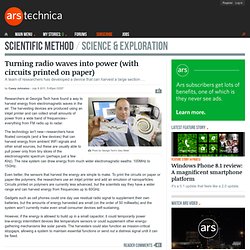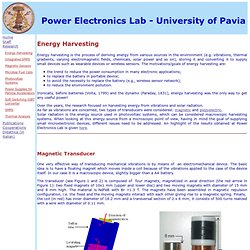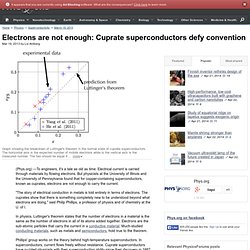

Advances in Energy Harvesting Methods - Google Books. Turning radio waves into power (with circuits printed on paper) Researchers at Georgia Tech have found a way to harvest energy from electromagnetic waves in the air.

The harvesting devices are produced using an inkjet printer and can collect small amounts of power from a wide band of frequencies--everything from FM radio up to radar. The technology isn't new—researchers have floated concepts (and a few devices) that can harvest energy from ambient WiFi signals and other small sources, but these are usually able to pull power only from tiny slices of the electromagnetic spectrum (perhaps just a few KHz). 00790616, version 1] Récupération d'énergie à partir des vibrations ambiantes : dispositif électromagnétique et circuit électronique d'extraction synchrone. cap.ee.ic.ac.uk/~pdm97/powermems/2011/Poster/P-23.pdf. spiral.imperial.ac.uk/bitstream/10044/1/9141/1/TCAS2_el_mag_tuning_mitcheson.pdf.
Electromagnetic Energy Harvesting. An experimental study on self-powered vibration control and monitoring system using electromagnetic TMD and wireless sensors. Abstract This paper proposed and validated a self-powered vibration control and monitoring (SVCM) system which consists of a pendulum-type tuned mass damper (TMD), a rotary electromagnetic (EM) device, an energy harvesting circuit (EHC) and a wireless smart sensor (WSS).

As the key element in the system, the regenerative electromagnetic TMD (EMTMD) is able to convert vibration energy of structures to electrical energy, and thus plays dual functions, namely, vibration mitigation and energy harvesting. With the aid of EHC, the electrical energy can be further stored and used to power WSS that closely monitor structural vibration responses. The feasibility of the proposed SVCM system was validated via shaking table tests, in which a single-degree-of-freedom (SDOF) structural model equipped with the SVCM system was tested under random excitations. Power Electronics Lab - University of Pavia. Energy harvesting is the process of deriving energy from various sources in the environment (e.g. vibrations, thermal gradients, varying electromagnetic fields, chemicals, solar power and so on), storing it and converting it to supply small devices such as wearable devices or wireless sensors.

The motivations/goals of energy harvesting are: the trend to reduce the power consumption in many electronic applications; to replace the battery in portable device; to avoid the necessity to replace the battery (e.g., wireless sensor network); to reduce the environment pollution. Ironically, before batteries (Volta, 1799) and the dynamo (Faraday, 1831), energy harvesting was the only way to get any useful power! Over the years, the research focused on harvesting energy from vibrations and solar radiation. As far as vibrations are concerned, two types of transducers were considered: magnetic and piezoelectric.
Magnetic Transducer. Energy-harvesting chips and the quest for everlasting life. Datasheets.com EBN.com EDN.com EETimes.com Embedded.com PlanetAnalog.com TechOnline.com Events ▼ UBM Tech UBM Tech ▼ datasheets.com EBN.com EDN.com EETimes.com Embedded.com PlanetAnalog.com TechOnline.com TMWorld.com To save this item to your list of favorite EE Times content so you can find it later in your Profile page, click the "Save It" button next to the item.

Latest News Semiconductor News Blogs Message Boards Advanced Technology Analog Boards/Buses Electromechanical Embedded Tools FPGAs/PLDs Logic & Interfaces Memory Operating Systems Optoelectronics Passives Power Processors RF/Microwave Sensors & Transducers Test & Measurement EE Live! DesignCon. Electromagnetic Harvester - Dennis Siegel - Dennis Siegel. The omnipresence of electromagnetic fields is implied just by simple current flow.

We are surrounded by electromagnetic fields which we are producing for information transfer or as a byproduct. Many of those fields are very capacitive and can be harvested with coils and high frequency diodes. Accordingly, I built special harvesting devices that are able to tap into several electromagnetic fields to exploit them. The energy is stored in an usual battery. So you can for example gain redundant energy from the power supply of a coffee machine, a cell phone or an overhead wire by holding the harvester directly into the electromagnetic field whose strength is indicated by a LED on the top of the harvester. Electromagnetic Harvester. Electrons are not enough: Cuprate superconductors defy convention. (Phys.org) —To engineers, it's a tale as old as time: Electrical current is carried through materials by flowing electrons.

But physicists at the University of Illinois and the University of Pennsylvania found that for copper-containing superconductors, known as cuprates, electrons are not enough to carry the current. "The story of electrical conduction in metals is told entirely in terms of electrons. The cuprates show that there is something completely new to be understood beyond what electrons are doing," said Philip Phillips, a professor of physics and of chemistry at the U. of I.
In physics, Luttinger's theorem states that the number of electrons in a material is the same as the number of electrons in all of its atoms added together. Electrons are the sub-atomic particles that carry the current in a conductive material. Phillips' group works on the theory behind high-temperature superconductors. Explore further: Impurity size affects performance of emerging superconductive material. Hollow Thermoelectric ) Flashlight by 15 year old Ann Makosinski.